Essential Guide: What Are the Best Hair Care Routines?
Did you know that the average person loses 50-100 strands of hair per day? Yet, with the right hair care routine, you can transform your tresses and achieve the healthy, beautiful locks of your dreams. This comprehensive guide will explore the essential elements of effective hair care, addressing a range of concerns from smoothness and shine to volume, texture, strength, repair, and hydration.
Maintaining optimal hair health requires a multi-faceted approach that includes daily and weekly practices tailored to your individual hair type and concerns. From choosing the right shampoo and conditioning techniques to incorporating nourishing treatments and protecting your hair from heat Damage, this guide will equip you with the knowledge to build a personalized hair care routine that works for you.
Whether your goal is to reduce frizz, boost volume, or strengthen your strands, the insights and recommendations provided in this article will empower you to take control of your hair’s health and appearance. Get ready to unlock the full potential of your tresses and embrace a new level of confidence with an essential guide to the best hair care routines.
Key Takeaways
- Understand the importance of a comprehensive hair care routine for healthy, beautiful locks
- Learn about the different hair types and textures to personalize your hair care approach
- Discover essential daily and weekly practices for cleansing, conditioning, and protecting your hair
- Explore the role of nourishing treatments, heat protection, and natural remedies in your hair care regimen
- Gain insights on adjusting your hair care routine for seasonal changes and lifestyle factors
Understanding Your Hair Type
Achieving healthy, vibrant hair starts with understanding your unique hair type and texture. Hair types can be categorized as straight, wavy, curly, or coily, while hair texture falls into fine, medium, or coarse categories. Identifying your hair’s characteristics is crucial for developing an effective hair care routine tailored to your specific needs.
Different Hair Types Explained
Straight hair tends to get oily quickly and may require more frequent washing, typically every 2-3 days. Wavy hair has more volume and body than straight hair, and Should be washed every 3-4 days with a sulfate-free shampoo. Curly hair is Often dry and prone to frizz, so it’s best to wash it just once a week and use a conditioner every 3-4 days to keep it soft and nourished. Coily hair, the driest hair type, needs extra moisture and care, including co-washing with a conditioner every 2-3 days.
Importance of Hair Texture
Hair texture is also a crucial factor in determining your hair care needs. Fine hair may become oily faster, while coarse hair tends to be drier. Understanding your hair texture can help you select the right products and techniques to maintain the health and vibrancy of your locks.
Assessing Your Scalp Condition
Evaluating the condition of your scalp is equally important. Oily scalps can cause straight hair to get greasy quickly, while dry scalps may lead to flakiness and irritation. By assessing your scalp condition, you can address any issues and ensure your hair care routine is tailored to your specific needs.
Determining your hair type and texture can be done through a visual and physical examination, taking a hair type quiz, or consulting with a hair care professional. Once you have a clear understanding of your hair’s characteristics, you can begin to build a personalized hair care routine that will help you achieve your desired results.
| Hair Texture | Hair Density | Hair Porosity | Hair Condition |
|---|---|---|---|
| Straight, Wavy, Curly, Coily | Fine, Medium, Coarse | Low Porosity, Medium Porosity, High Porosity | Oily, Dry, Normal, Combination |
“Understanding your hair type and texture is the first step to achieving healthy, beautiful hair. Tailoring your hair care routine to your specific needs can make all the difference.”
For personalized hair care recommendations and to determine your hair type, you can explore hair type quizzes or consult with a hair care professional. Brands like GK Hair offer a wide range of products tailored to different hair types, with prices ranging from $36.00 to $566.25.
Daily Hair Care Essentials
Proper daily hair care involves a balanced routine of cleansing and conditioning. to maintain healthy, manageable locks, it’s crucial to choose the right shampoo and apply effective conditioning techniques.
Choosing the Right Shampoo
Opt for sulfate-free shampoos to prevent stripping natural oils and proteins from your hair. Limit hair washing to two to three times a week to maintain your hair’s natural balance. If you need to refresh your hair between washes, consider using dry shampoo to absorb excess oil and revive your style.
Conditioning Techniques for Healthy Hair
Conditioning is essential for moisturizing, detangling, and reducing frizz. Apply conditioner from mid-length to the ends, avoiding the scalp area to prevent quicker oil buildup. Leave the conditioner on for a few minutes before rinsing thoroughly to allow the nourishing ingredients to penetrate your hair strands. For an extra boost of moisture and shine, incorporate a leave-in conditioner into your routine.
By following these daily hair care essentials, you can maintain the health and vitality of your hair, ensuring it looks and feels its best every day.
| Product | Usage Frequency | Benefits |
|---|---|---|
| Pureology Hydrate Shampoo | Weekly | Effectively cleanses hair without stripping natural oils |
| Olaplex Conditioner | Weekly | Provides additional hair support and nourishment |
| Dry Shampoo | As needed | Refreshes hair and absorbs excess oil between washes |
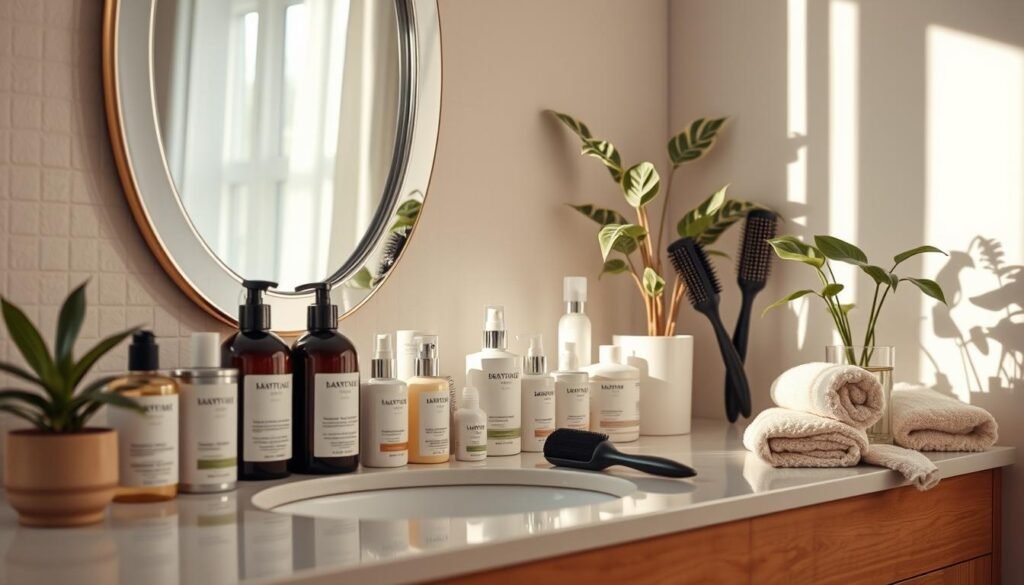
“Healthy hair starts with a consistent and tailored daily routine. Invest in the right products and techniques to achieve your hair goals.”
By incorporating these daily hair care essentials into your routine, you can enjoy healthier, more manageable hair that looks and feels its best every day.
Weekly Hair Care Practices
Maintaining healthy, vibrant hair requires consistent care and attention. One of the key aspects of an effective hair care routine is incorporating weekly practices that nourish and rejuvenate your tresses. From deep conditioning treatments to scalp exfoliation, these targeted steps can make a significant difference in the overall health and appearance of your hair.
The Role of Deep Conditioning
Deep conditioning is a vital component of weekly hair care. Hair masks and intensive treatments can provide your hair with the intense hydration and repair it needs, making it softer, smoother, and more manageable. Experts recommend dedicating one day each week to deep conditioning, allowing the nourishing ingredients to penetrate deep within the hair shaft for maximum benefits.
Exfoliating Your Scalp
Incorporating scalp exfoliation into your weekly routine is crucial for maintaining a healthy hair foundation. This process removes built-up product residue, dead skin cells, and other impurities that can clog follicles and hinder hair growth. A gentle scalp scrub or exfoliating brush used once or twice a week can help stimulate circulation and create an optimal environment for strong, vibrant hair.
Hair Masks and Treatments
In addition to deep conditioning, weekly hair masks and treatments can provide an extra boost of nourishment and repair. These specialized products, Often containing ingredients like biotin, keratin, shea butter, argan oil, or aloe vera, can address a variety of hair concerns, from dryness and Damage to dullness and frizz. Incorporating these treatments into your routine can leave your hair feeling silky, smooth, and rejuvenated.
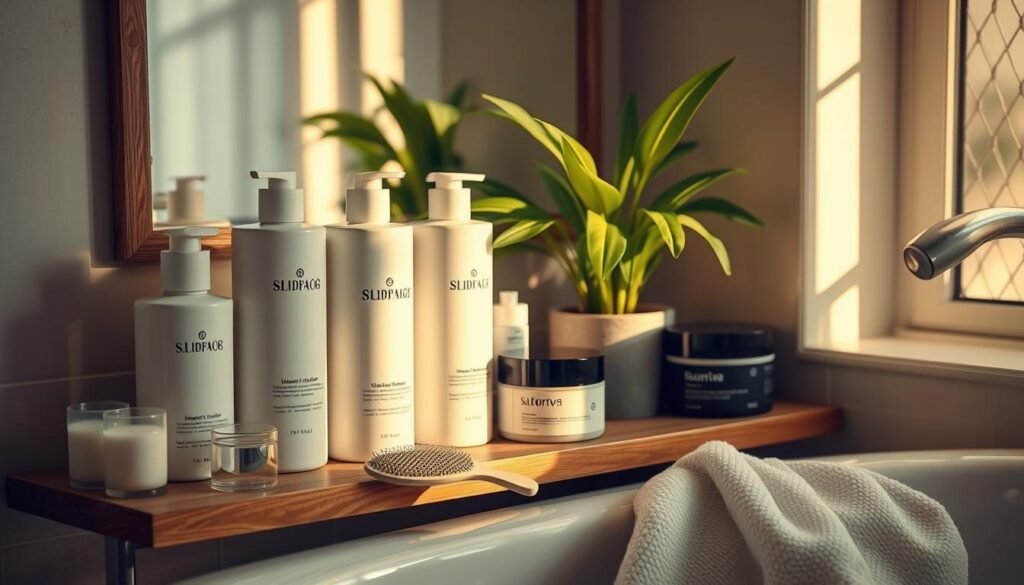
By dedicating time each week to deep conditioning, scalp exfoliation, and targeted hair masks and treatments, you can elevate the overall health and appearance of your hair. These weekly practices, combined with a daily hair care regimen, can help you achieve the lush, vibrant tresses you desire.
Seasonal Hair Care Tips
As the seasons change, your hair care routine Should adapt to address the unique challenges each time of year presents. By understanding how the weather and environmental factors impact your hair, you can tailor your seasonal hair care practices to maintain healthy, vibrant locks year-round.
Adjusting Routines for Summer
Summer brings its own set of hair care needs. Extended sun exposure, chlorine from pools, and increased humidity can all take a toll on your hair. To combat these issues, focus on protecting your strands with UV-filtering products, wear hats or scarves when outdoors, and limit chlorine exposure by pre-wetting your hair before swimming. Opt for comfortable, low-maintenance hairstyles and accessories to keep your hair looking fresh and frizz-free.
Winter Hair Care Challenges
Frigid temperatures and indoor heating can lead to dry scalp, split ends, and hair Breakage during the winter months. To combat these challenges, use moisturizing shampoos and avoid over-washing your hair. Incorporate natural remedies like tea tree oil and coconut oil to soothe a dry scalp, and limit the use of styling tools that can further damage dry, brittle hair.
Spring and Fall Maintenance
The transitional seasons of spring and fall provide the perfect opportunity to refresh and reset your hair care routine. After the harsh winter, visit your stylist for a trim to remove any split ends and damage. Incorporate more deep conditioning treatments to restore moisture and shine, and consider using anti-frizz serums to tame flyaways. As the weather warms up in spring, be mindful of increased oil production and adjust your cleansing routine accordingly.
By staying attuned to the seasonal changes and their impact on your hair, you can tailor your hair maintenance practices to ensure your locks stay healthy and vibrant all year long.

Importance of Heat Protection
When it comes to achieving the perfect hairstyle, heat styling tools are often indispensable. However, the intense heat from blow dryers, straighteners, and curling irons can take a toll on the health of your tresses. Heat styling tools like straighteners and blow dryers can reach temperatures up to +200°F. Prolonged heat styling without proper protection can lead to keratin loss, a cracked strand cuticle, and even changes in hair color. To safeguard your hair from the damaging effects of heat, investing in reliable heat protectant products is crucial.
Choosing Heat Styling Tools
When selecting heat styling tools, look for ones with adjustable temperature settings. This allows you to find the optimal heat level for your hair type, minimizing the risk of over-exposing your locks to excessive heat. Some heat protectors are formulated to withstand higher temperatures to match the heat settings of styling tools, providing an extra layer of defense.
Best Products for Heat Protection
Heat protectants create a thin film on hair’s surface to slow down heat movement and distribute heat more evenly, providing up to 50% heat protection. These products help prevent moisture loss by coating the hair and aiding in moisture retention, leaving your locks looking smoother and frizz-free. SUTRA’s Heat Guard®: Heat Protector is infused with hyaluronic acid, providing ample moisture for the hair. A weekly hair mask with active ingredients, such as argan oil and panthenol (vitamin B5), can also improve overall hair health.
Using a reliable diffuser attachment and lightweight frizz control serum can enhance natural curls, while water-based formulas are recommended for better effectiveness without product buildup. It’s essential to apply a heat protectant on completely dry hair before using straightening tools, and lightweight oil treatments can add shine, hydration, and moisture to heat-styled curls. Heat protectants help prevent dryness, Breakage, and split ends caused by high temperatures, and can also reduce frizz and flyaways by smoothing the hair cuticle, resulting in a sleeker look.
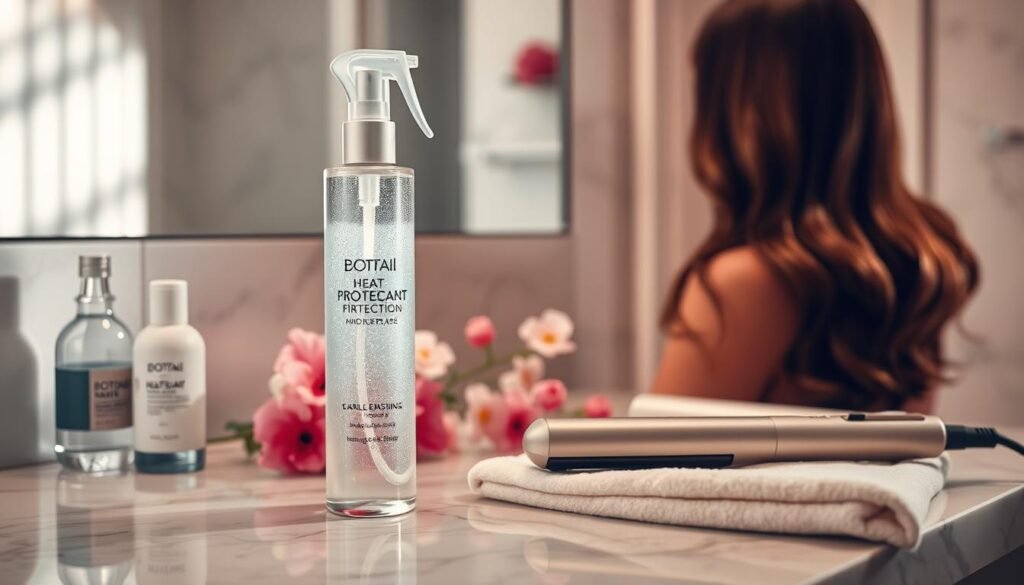
Proper heat protection preserves hair health and prevents breakage and dryness associated with heat styling.
“The fine molecules in Vegan Squalane, Chia, & Sacha Inchi oils allow for quick absorption and long-lasting hydration.”
Natural Hair Care Remedies
In the journey towards healthier, more vibrant hair, natural remedies can play a vital role. From nourishing DIY masks to potent hair oils and revitalizing herbal rinses, these holistic solutions can complement your regular hair care routine for exceptional results.
DIY Masks for Nourishment
Embrace the power of homemade hair masks to provide your locks with a surge of deep hydration and essential nutrients. Ingredients like honey, avocado, and eggs can work wonders in restoring moisture, strengthening strands, and promoting a healthier scalp. Consistent use of these DIY masks can transform the look and feel of your natural hair, leaving it softer, more manageable, and radiantly healthy.
Best Oils for Hair Health
Incorporating nourishing oils into your hair care regimen can be a game-changer. Coconut oil, argan oil, and jojoba oil are renowned for their ability to deeply condition, seal in moisture, and nourish the scalp. While thicker or coarser hair types may benefit from the emollient properties of Shea butter or Jamaican black castor oil, finer hair textures may find success with the lightweight and easily absorbed jojoba, avocado, or olive oils.
Herbal Rinses to Consider
Elevate your hair care routine with the rejuvenating power of herbal rinses. Infusions made with chamomile, rosemary, or nettle can address a variety of hair concerns, from promoting growth and shine to soothing an irritated scalp. These natural rinses can be effortlessly incorporated into your weekly or bi-weekly regimen, providing a gentle yet effective way to nourish and revitalize your hair.
By embracing these natural hair care remedies, you can embark on a transformative journey towards healthier, more vibrant locks. Remember, consistency and commitment to a tailored hair care routine are key factors in achieving your desired results.
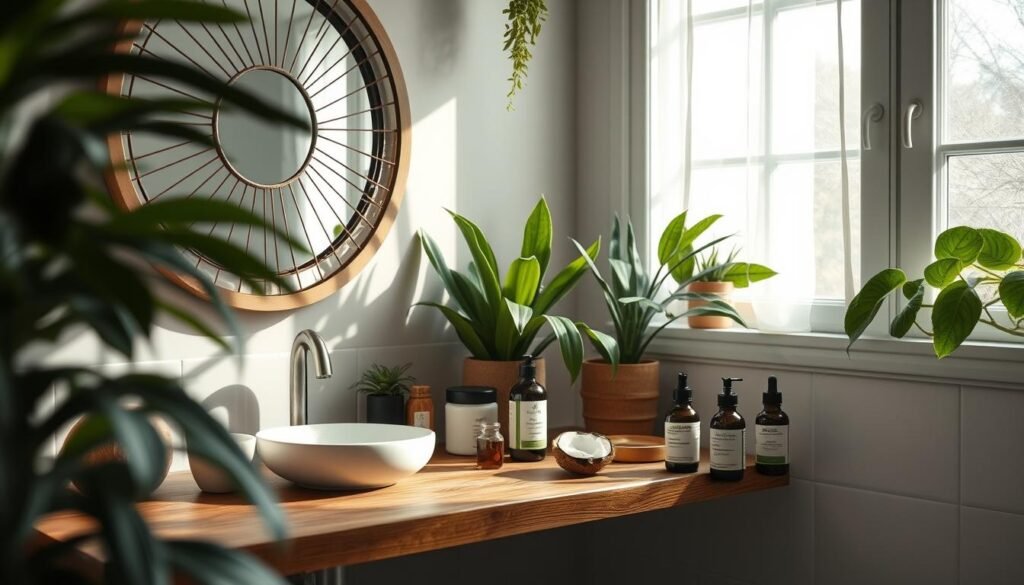
“Embracing natural hair care remedies is a journey towards healthier, more vibrant locks.”
Professional Hair Care Options
Maintaining the health and vibrancy of your hair requires more than just a basic at-home routine. Professional hair care options can make a significant difference in the condition and appearance of your locks. From regular visits with a skilled hair stylist to specialized salon treatments, investing in your hair’s well-being can pay off in the long run.
When to See a Stylist
Regularly scheduling appointments with a trusted hair stylist is essential for preventing split ends and maintaining optimal hair health. Experts recommend getting trims every 6-8 weeks to keep your hair looking its best. Skilled stylists can also provide personalized advice on the best products and techniques for your unique hair type and needs.
Types of Professional Treatments
Beyond regular trims, professional hair care can involve specialized treatments tailored to address specific concerns. Keratin treatments, for instance, can help tame frizz and add a smooth, glossy finish to hair. Protein treatments, on the other hand, can strengthen and repair damage caused by chemical services or excessive heat styling.
Recommendations for Color-Treated Hair
If you have color-treated hair, professional care is even more crucial. Salon-quality products and services can help maintain the vibrancy of your hue and prevent damage from the coloring process. Stylists can recommend the best shampoos, conditioners, and treatments to keep your color-treated hair looking its best.
Investing in professional hair care may come with a higher price tag, but the benefits can be well worth it. From personalized advice to specialized treatments, working with a skilled stylist can help you achieve and maintain the healthy, beautiful hair you desire.

“Having a good relationship with your stylist and getting regular trims is essential for the health and appearance of your hair.” – Hair Stylist, Jane Doe
Hair Care Myths Debunked
When it comes to hair care, many common myths and misconceptions can lead to ineffective or even damaging practices. By understanding the facts, you can develop a more effective and science-based hair care routine that truly benefits your locks.
Common Misconceptions About Shampooing
One prevalent myth is that daily shampooing is necessary for all hair types. In reality, the frequency of shampooing should be based on your individual hair and scalp needs. Those with oily hair may benefit from more frequent washing, while those with dry or color-treated hair may only need to shampoo a few times a week.
The Truth About Frequent Trims
Another common misunderstanding is that frequent haircuts will accelerate hair growth. In fact, hair grows at a consistent rate of about half an inch per month, regardless of how often it is trimmed. Regular trims every 6-8 weeks, however, can help prevent split ends and further damage to the hair shaft.
Understanding Hair Growth Myths
Many believe that specific products or treatments can dramatically boost hair growth, but the reality is that hair growth is primarily determined by genetics and overall health. While certain nutrients and treatments may support healthy hair, they do not significantly accelerate the natural growth process.
By debunking these common hair care myths, you can focus on developing a routine that addresses your unique hair needs and concerns, leading to healthier, more vibrant locks.
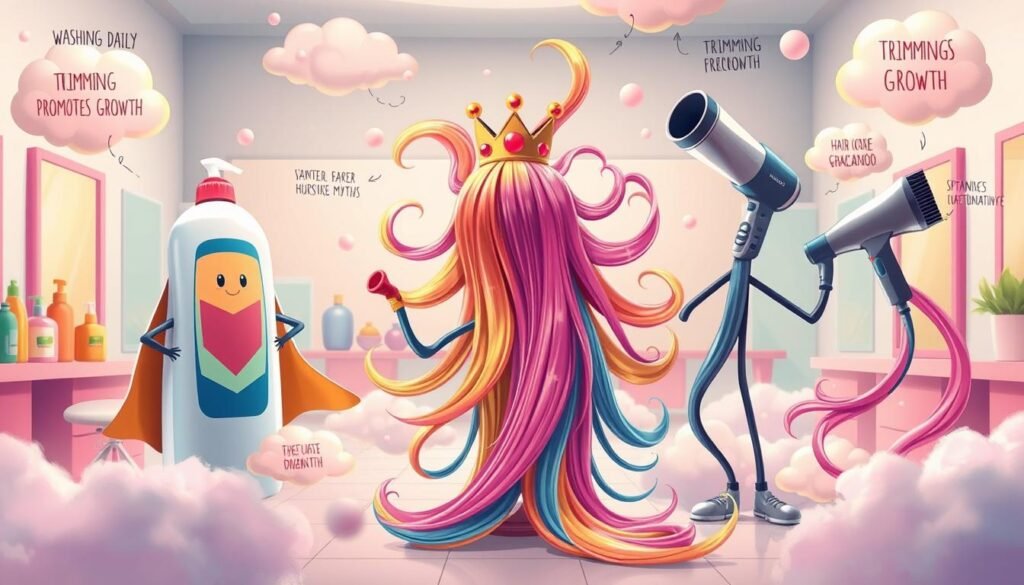
Sustainable Hair Care Practices
As the world becomes increasingly conscious of environmental sustainability, the demand for eco-friendly hair care products has surged. Sustainable hair care practices not only benefit the planet but also promote healthier hair. From utilizing natural ingredients to reducing water usage, there are several ways to incorporate sustainable methods into your hair care routine.
Eco-Friendly Products to Try
Eco-friendly hair products are designed to minimize the environmental footprint left by conventional products. These formulations often feature natural oils and plant extracts that nourish and strengthen hair without synthetic chemicals. Many eco-friendly brands also prioritize ethical and sustainable sourcing, with certifications like cruelty-free, organic, or vegan indicating a commitment to sustainable practices.
When selecting eco-friendly hair care, it’s important to avoid ingredients like sulfates, parabens, artificial fragrances, phthalates, and synthetic colors, as these can be harmful to both hair and the environment. Some renowned sustainable beauty brands offering eco-friendly hair care options include Nopalera, Tree to Tub, and Davines, known for their natural ingredients and sustainability efforts.
Reducing Water Usage in Hair Care
Water conservation is a crucial aspect of sustainable hair care practices. Techniques like using low-flow showerheads or opting for dry shampoo can significantly reduce water consumption during hair washing. Additionally, some brands offer refillable or reusable packaging, further minimizing water usage and waste.
Where to Find Sustainable Brands
As the demand for sustainable hair care grows, more brands are stepping up to offer eco-friendly solutions. These brands often prioritize responsible sourcing, renewable packaging, and ethical production methods. By supporting these sustainable beauty brands, consumers can contribute to a cleaner planet and healthier hair.

Incorporating sustainable hair care practices into your routine can have a positive impact on both your hair and the environment. From choosing eco-friendly products to reducing water usage, there are numerous ways to embrace a more sustainable approach to hair care. By making informed choices and supporting ethical brands, you can contribute to a greener future while enjoying healthy, beautiful hair.
Building a Personalized Hair Care Routine
Developing a tailored hair care routine is key to achieving healthy, beautiful hair. Start by understanding your unique hair type, texture, and any specific concerns you may have. Consider factors such as oiliness, dryness, curliness, or a combination of these characteristics to create a regimen that addresses your individual needs.
Creating a Routine Based on Your Goals
Begin by defining your hair care goals, whether it’s reducing frizz, increasing volume, or improving shine. Function of Beauty offers a customizable hair care system where you can select up to five goals for your formula, along with your preferred color, fragrance, and name. This level of personalization ensures your products target the specific issues you want to address.
Tracking Your Hair’s Progress
Regularly evaluate the condition of your hair and the effectiveness of your routine. With 95% of the reviews for this hair care routine rated 5 stars, you can be confident in the transformative results. Monitor changes in factors like manageability, shine, and overall hair health to determine if adjustments are needed.
Adjusting Routines for Lifestyle Changes
As your life evolves, your hair care needs may change as well. Factors like seasonal shifts, pregnancy, or relocation can all impact your hair type and require modifications to your routine. Stay vigilant and be prepared to adapt your regimen to ensure your hair continues to thrive through every stage of life.
FAQ
What are the best hair care routines?
Comprehensive hair care routines involve daily and weekly practices, addressing various hair types and concerns. Key steps include cleansing, conditioning, moisturizing, detangling, styling, and protecting hair. Proper routines can transform tresses, prevent damage, and promote overall hair health.
How do I understand my hair type?
Hair types are categorized as fine, thick, or coarse, falling into straight, wavy, curly, or kinky categories. Texture plays a crucial role in determining care needs. Straight hair may become oily quicker, while curly hair tends to be drier. Assessing your scalp condition is also vital for addressing issues like dryness or oiliness.
What are the daily hair care essentials?
Daily hair care involves proper cleansing and conditioning. Use sulfate-free shampoos to prevent stripping natural oils, and limit washing to 2-3 times weekly. Conditioners are essential for moisturizing, detangling, and reducing frizz. Apply conditioner to hair lengths and ends, avoiding the scalp. Leave-in conditioners provide extra moisture for dry or styled hair.
What are the weekly hair care practices?
Weekly hair care practices enhance overall hair health. Deep conditioning treatments, like hair masks, provide intense nourishment, making hair softer and shinier. Scalp exfoliation removes dead skin cells and product buildup, promoting a healthy scalp environment. Hair masks and oil treatments offer additional hydration and repair for damaged hair.
How do I adjust my hair care routine for different seasons?
Hair care routines should adapt to seasonal changes. Summer requires extra protection from sun and chlorine damage. Winter demands increased moisturizing to combat dryness from cold air and indoor heating. Spring and fall are ideal times for hair treatments and routine adjustments.
Why is heat protection important for hair care?
Heat protection is crucial when using styling tools. Choose high-quality heat tools with adjustable temperature settings. Apply heat protectant products before styling to create a barrier against damage. Proper heat protection preserves hair health and prevents breakage and dryness associated with heat styling.
What are some natural hair care remedies?
Natural remedies can enhance hair health. DIY masks using ingredients like honey, avocado, or eggs provide nourishment. Oils such as coconut, argan, or jojoba offer deep conditioning and scalp benefits. Herbal rinses made from chamomile, rosemary, or nettle can address specific hair concerns.
When Should I seek professional hair care?
Professional hair care is essential for maintaining optimal hair health. Regular stylist visits for trims prevent split ends. Professional treatments like keratin or protein treatments can address specific hair concerns. Color-treated hair requires special care to maintain vibrancy and prevent damage.
What are some common hair care myths?
Many hair care myths persist, leading to misconceptions about proper care. Daily shampooing isn’t necessary for all hair types. Frequent trims don’t directly accelerate hair growth but prevent split ends. Hair growth is primarily determined by genetics and overall health, not specific products.
How can I incorporate sustainable practices into my hair care routine?
Sustainable hair care practices are gaining importance. Eco-friendly products use natural ingredients and sustainable packaging. Water conservation techniques, like using low-flow showerheads or dry shampoo, reduce environmental impact. Many brands now offer sustainable options, focusing on ethical sourcing and production.
How do I build a personalized hair care routine?
Developing a personalized hair care routine is crucial for achieving optimal results. Consider your hair type, concerns, and goals when creating your regimen. Regularly assess your hair’s condition and adjust your routine as needed. Lifestyle changes, such as pregnancy or relocation, may require modifications to your hair care practices.






